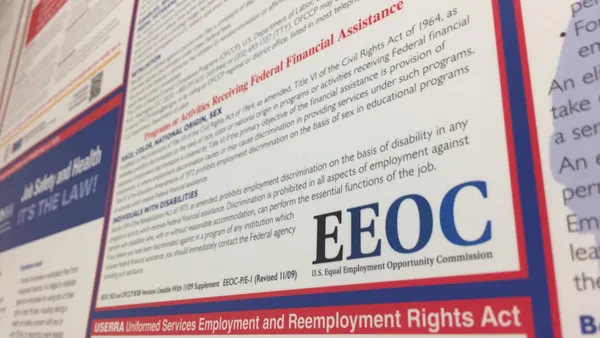The U.S. Equal Employment Opportunity Commission proposed Monday enforcement guidance on workplace harassment after more than a half-decade of public debate and commentary.
The document is structured around the three components of a harassment claim, including determining whether the harassment is based on an employee’s legally protected characteristics; whether the harassing conduct resulted in discrimination with respect to a term, condition or privilege of employment; and whether there is a basis for holding the employer liable for the conduct.
Subjects addressed in the guidance include harassment on the basis of sexual orientation and gender identity in light of the U.S. Supreme Court’s ruling in Bostock v. Clayton County, Ga. EEOC listed examples of sex-based harassment, such as intentional and repeated use of a name or pronoun inconsistent with an individual’s gender identity, as well as denial of access to a bathroom or other sex-segregated facility consistent with an individual’s gender identity.
Other sections address the scope of what constitutes a hostile work environment. Conduct that occurs in a work-related context outside of an employee’s regular workplace may contribute to a hostile work environment, EEOC said, including conduct in a virtual work environment.
“This can include, for instance, sexist comments made during a video meeting, racist imagery that is visible in an employee’s workspace while the employee participates in a video meeting, or sexual comments made during a video meeting about a bed being near an employee in the video image,” the agency wrote.
A public comment period on the agency’s proposed guidance will close Nov. 1, 2023, according to a Federal Register notice. In an accompanying statement, EEOC Chair Charlotte Burrows said the contents of the finalized guidance document “will not have the force and effect of law and are not meant to bind the public in any way,” but are instead “intended only to provide clarity to the public regarding [EEOC] policies and existing requirements under the law.”
EEOC indicated that it would update its enforcement guidance as far back as June 2016, when a commission task force co-chaired by former Commissioners Victoria Lipnic and Chai Feldblum said the agency was in the process of doing so. Then came a cascade of legal developments, including the investigations published as part of the #MeToo movement, the Bostock decision and the pandemic.
The agency previously issued a technical assistance document on harassment prevention in 2017, but its most recent proposal accounts for several major shifts in the employment law landscape since that time, said Stephen Paskoff, president and CEO at Employment Learning Innovations and former EEOC trial attorney.
For instance, the guidance not only addresses developments in off-site work and LGTBQ+ discrimination, but also the effects of systemic discrimination. EEOC wrote that a finding of systemic harassment could indicate that all employees of a protected group have been subjected to the same circumstances.
“You’ve got to read these [guidelines] in the context that the EEOC has said it is going to be more focused on systemic discrimination than it had during the period before 2017,” Paskoff said, “and that means broad-based claims being filed with increasing frequency.”
Paskoff suggested employers analyze their harassment prevention practices and ensure leaders take initiative in reinforcing those practices.
“Employers are well-advised to take a look at whether they have active values that help to not just ensure people prevent and don’t engage in the kind of behaviors that are met with real written examples in these guidelines, but [also] get people to speak about those issues,” Paskoff said. “Getting people to speak up is critically important.”












